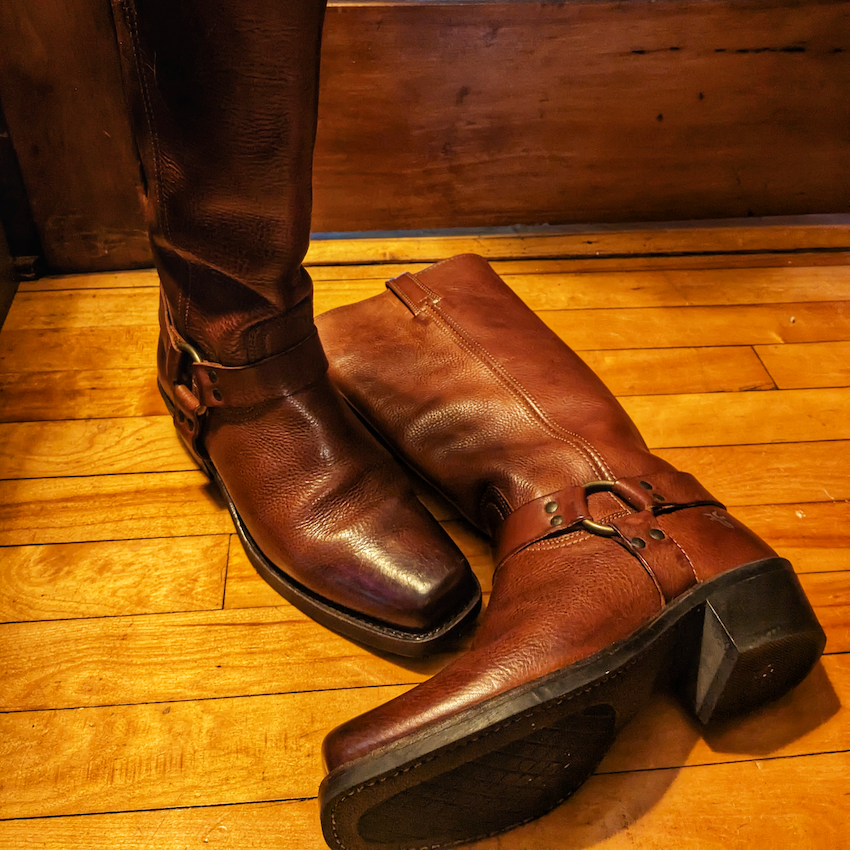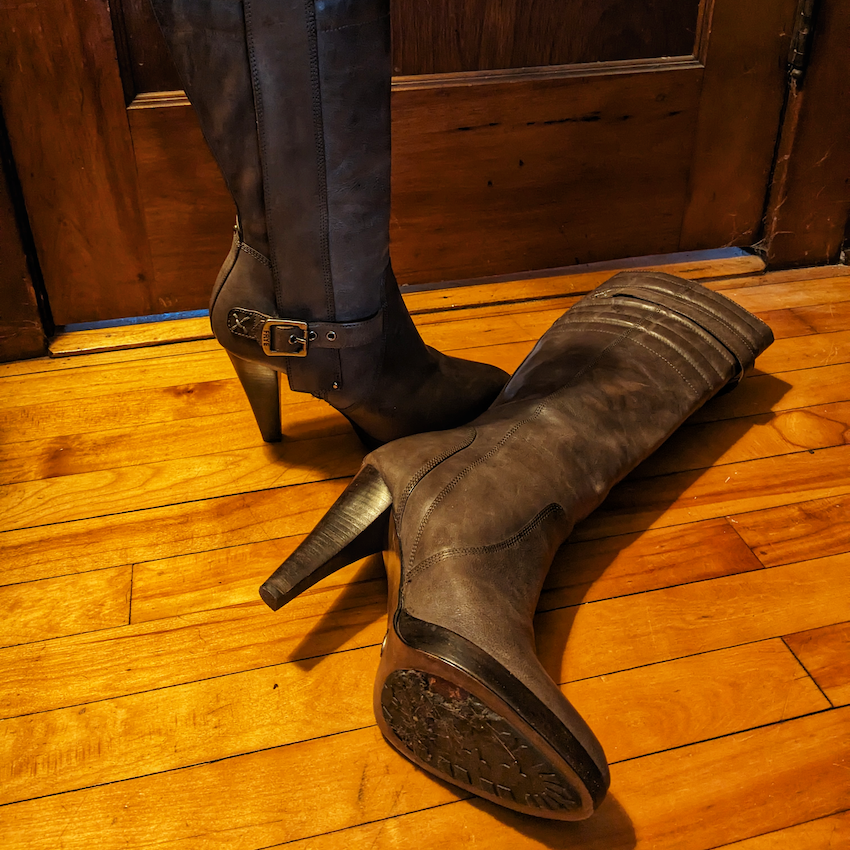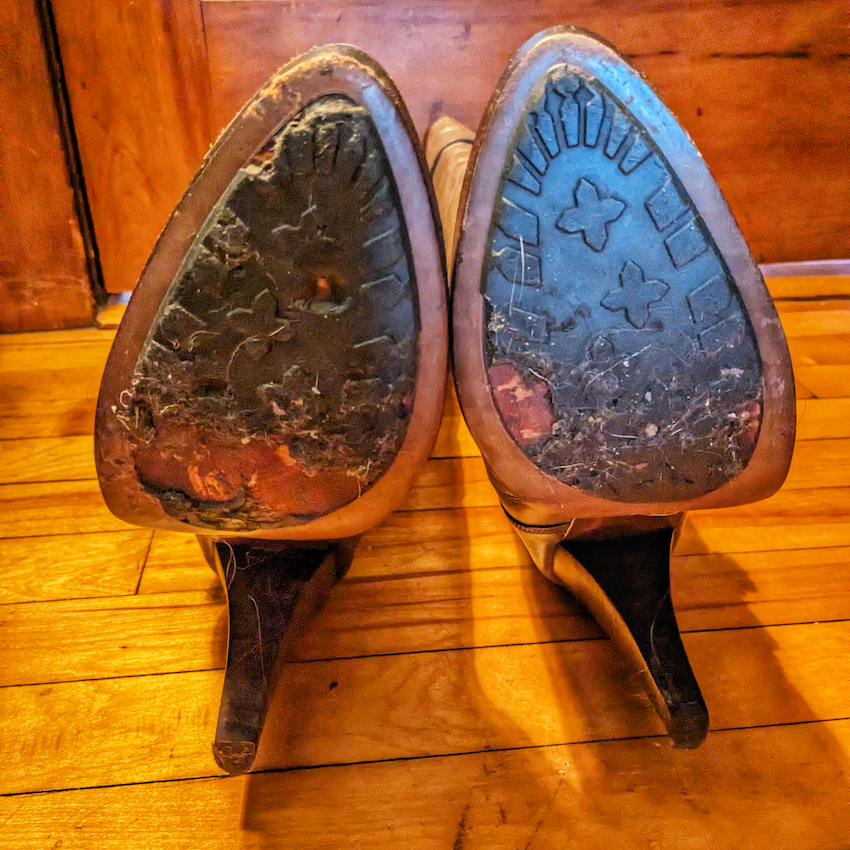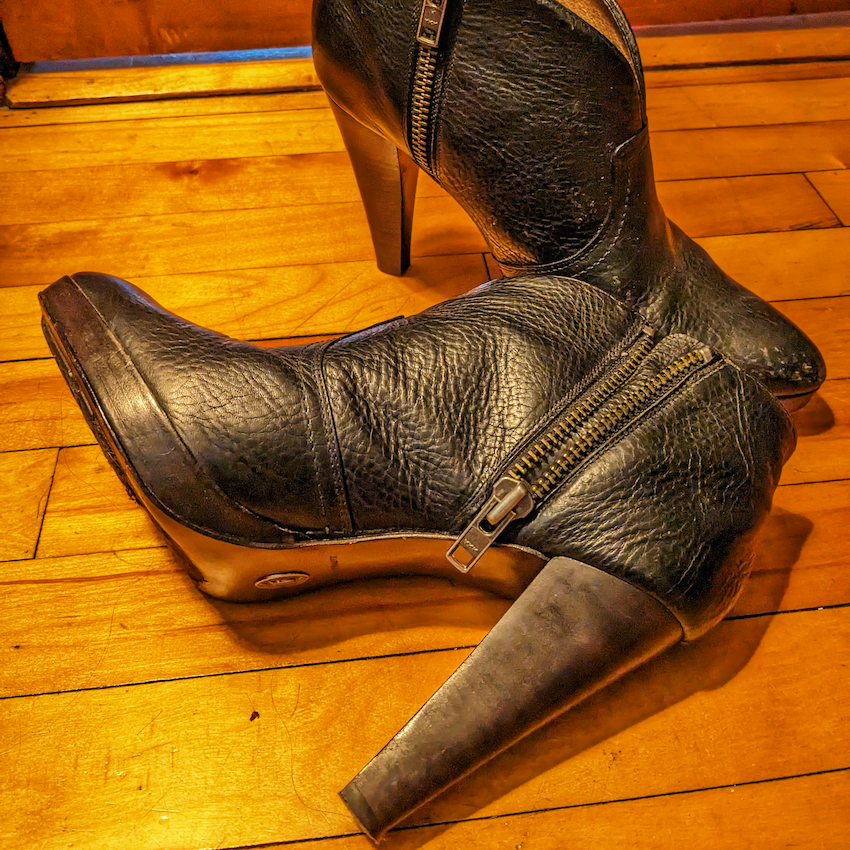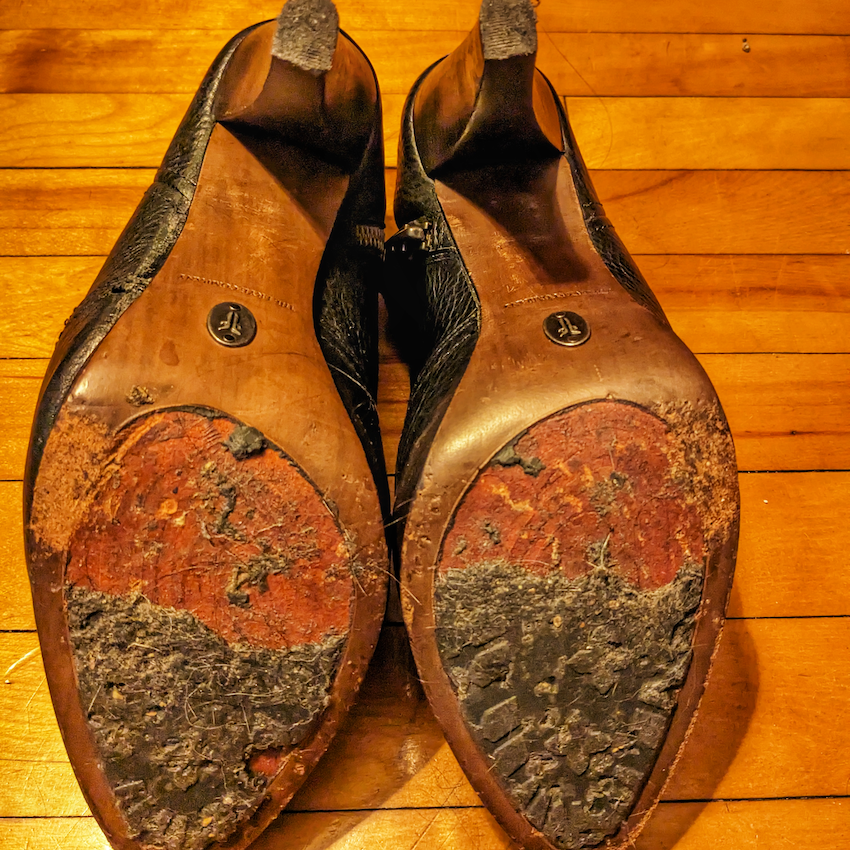
This is definitely a brand profile that's long overdue.
The Frye Company is widely regarded an American footwear icon; worn in literal battle by President Theodore Roosevelt and the Rough Riders, by U.S. soldiers in World War II, and as a fashion staple from the 1960's to current day. The balance of their rugged toughness & utilitarian design to clean, sleek, dressy-yet-no-nonsense lines and curves have earned them a strong and dedicated following over the years. The very fact that the company has consistently existed in some business iteration for some 160 years, and counting, says something about their staying power.
But there's the rub. Through business acquisitions, mergers, transfer of branding & license, and whatever else businesses do to keep the name, it's easy to ask the question, is current-day Frye and 20th century Frye one and the same? That's the question we'll try to tackle as we take a look at the brand's history, design, manufacture and quality and weigh those aspects against price and overall attainability.
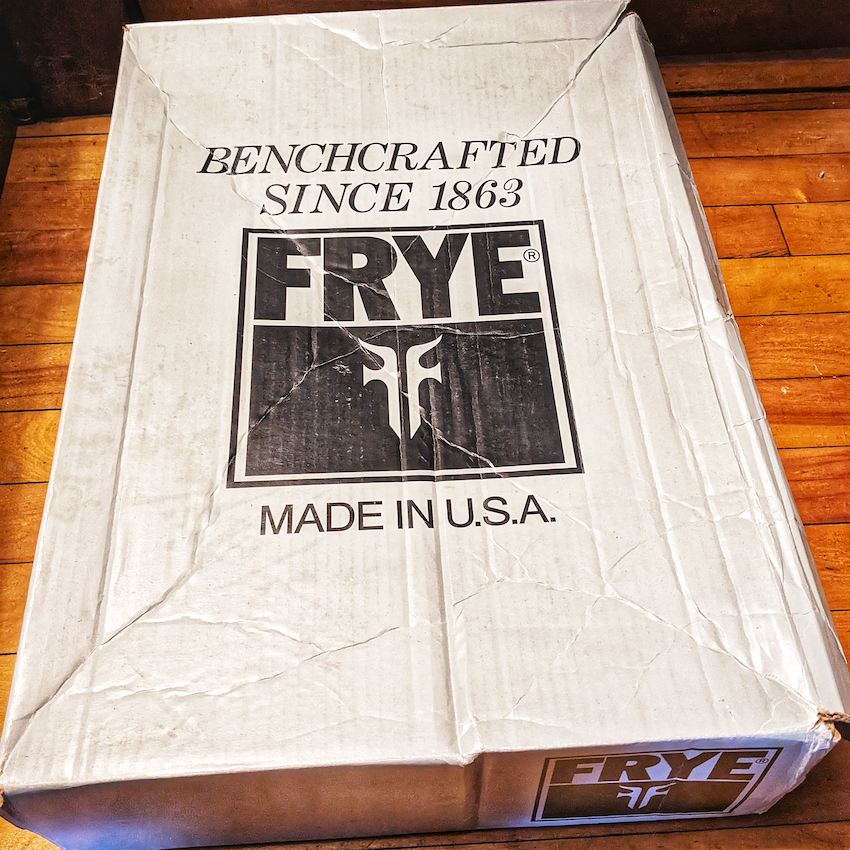
Just a Frye Shoe Box, circa 2014
(image copyright sartorialsleaze)
Frye — A 160-Year History in a Shoebox
Whether you have bought a Frye shoe or boot brand new from a recent collection or an older model calling back to 'The Days of the Covered Wagon' Frye will almost always reference their origin at the time of that seemingly coveted unboxing. After all, not very many brands...and very few if any footwear brands can say that they have been around since 1863. From the 'Heritage' section of the company's website,
In 1863, John A. Frye opened the doors to the very first Frye shop on Elm Street in Marlboro, MA, paving the way for countless generations of Frye artisans dedicated entirely to the art of craftmanship.[1]
Frye footwear has a lot of links to U.S. History generally; some historical references indicate that Frye boots were worn in the American Civil War, though this would need additional research to confirm as the company's history page indicates that though founder John A. Frye opened his shop in 1863 per the above, the page also indicates that the first Frye boot ever made was in 1868. Nonetheless, Frye was a wartime staple footwear for soldiers of multiple eras, from the Spanish-American war through World War II.
In terms of manufacturing process history, Frye integrated Goodyear Welt construction, a manufacturing process that adds an additional strip of leather (referred to as a 'welt') between the sole and the shoe/boot upper. Two layers of stitches are made; one binding the upper to the welt, and the other binding the welt to the outsole. This shoe construction method is widely regarded as a premium construction as it enables greater durability for the shoe/boot as well as allowing the footwear to be resoled with greater ease. (Note: Since there's a lot of history and manufacturing process regarding this construction method, a future post will highlight Goodyear welt construction in greater detail) Per Frye's profile, two-thirds of Frye footwear implemented this construction method by 1930, and three-fourths by 1936.
After World War II and into the 1960s, Frye started getting the attention of celebrities and public figures. It was during this era that two signature styles became staples in their collection; the Campus boot and the Harness boot. These two styles have been consistent throughout many seasons and continue to be marketed and sold through this day.
Toward the end of the 1970s, the Frye Company started going through ownership changes. Don Ireland, who bought the company from John A. Frye's grandson and the Frye family in 1944, sold the company to the Alberto-Culver company in 1977. Then, in 1985, Alberto-Culver sold the company to Stanley Kravetz. The company was then acquired by the Rockport Company (a Reebok subsidiary) in 1987, though Kravetz remained with the company as president.
A few years later, in 1993, licensing rights for Frye were granted to the Jimlar Corporation...a noteworthy acquisition as Jimlar also held licensing for Coach footwear at the time. In 1998, Kravetz purchased the company from the Rockport company and formally sold the company to Jimlar for an undisclosed amount (source: Wikipedia). Then in 2010, Chinese Corporation Li & Fung purchased Jimlar, and in 2014, Li & Fung spun off brand management to Global Brands Group.
Three years later in 2017, Authentic Brands Group purchased a 51% share of Frye from GBG for $100 million. A marketing push in 2017, with emphasis on a 'Made in the USA' theme and featuring various public figures commenced, and there was a push toward increasing a brick-and-mortar retail footprint. This effort ultimately stalled and fell out of focus as all retail locations closed by March of 2020. In 2021, Global Brands Group filed for voluntary chapter 11 bankruptcy, and GBG's license was acquired by Authentic Brands Group, which continues to hold ownership at time of writing.
Product iterations based on current collection. 1st image – Harness 15r in Redwood leather, 2nd image, Melissa over-the-knee boot in brown leather.
(Image credit: sartorialsleaze)
Product Offerings
In looking at Frye's current collection at time of writing, there are a series of multi-season styles in both the men's and women's collections:
- Harness Boot - The Harness is possibly the most well-known product that Frye sells. It's a square-toed boot with a Neoprene sole and straps of leather bound by 2 metal rings at the ankle, giving the boot it's signature Harness name. Current collections focus on an ankle boot, the Harness 8R and a mid-calf boot, the Harness 12R. In previous collections and highlighted by this sections corresponding image, Frye made a tall-shaft 15R variant but this is not an offering in current collections. The Harness is available in men's and women's sizing as unique offerings.
- Campus Boot - Similar to the Harness, this boot is a multi-season staple. Generally sold as a taller shaft style (a 14R by Frye's terminology), the boot features a slightly stacked heel. A well known color for this style is yellow (banana) leather, being featured in a lot of vintage advertising
- Melissa Boot - An equestrian-inspired style featuring a round toe and a flat heel. The Melissa is offered in 'shootie' and ankle-high styles, but most style variants feature a true knee-high shaft. The Melissa is available in pull-on and side-zip styles and with various ornamentation such as rings & leather straps around the ankle. Occasionally an over-the-knee style is offered, and an example can be seen in the section's image carousel.
- Jackie Boot - Very similar to the 'Melissa' but featuring a taller stacked heel, approx 2 - 2.5 inches
- Ivy Sneaker - A round-toe sneaker with a standard rubber outsole. Available as slip-on and lace-up variants
- Astor Sneaker - The men's style variant of the Ivy sneaker
While there are other multi-season models, the list above is the core products of a given season's collection
Product Production, Construction, and Quality
This is where the real substance of this article begins.
As referenced earlier, sometime in 2017 there was a marketing push with a 'Made in the USA' emphasis. Though with current research and items in my own collection there are three country of manufacture origins: the United States, Mexico, and China. For context, most of my Frye's were purchased between 2010 - 2017.
On a positive note, I can at least say that there's a consistent quality in the leather uppers between all three buckets of countries. They mostly feature relatively thick full-grain leathers, with the exception of my pair of Melissa boots, which were manufactured in Mexico and feature a smoother leather that's slightly thinner (note that I do not have a measurement tool to evaluate thickness but may explore in future articles).
With the common elements out of the way, I'll focus on the models in my collection individually.
Harness 15R -
As my only pair of Frye's manufactured in the United States, it seems fitting that the Harness is the standard for the company. For an almost $500 boot, it's not completely out of it's element for other footwear in this price range. The overall construction gives the boot a feel that it could last through many seasons with regular wear, and as a pull-on style the pull tabs on the side seem well-attached to the shaft uppers. Regarding the Goodyear welt, it seems evident although it's usually verified on a sole replacement due to the inner stitch between the welt and the base of the upper...but given the other details there's no reason to believe that Frye is being loose with the term.
We'll come back to the price point after providing details on the other footwear.
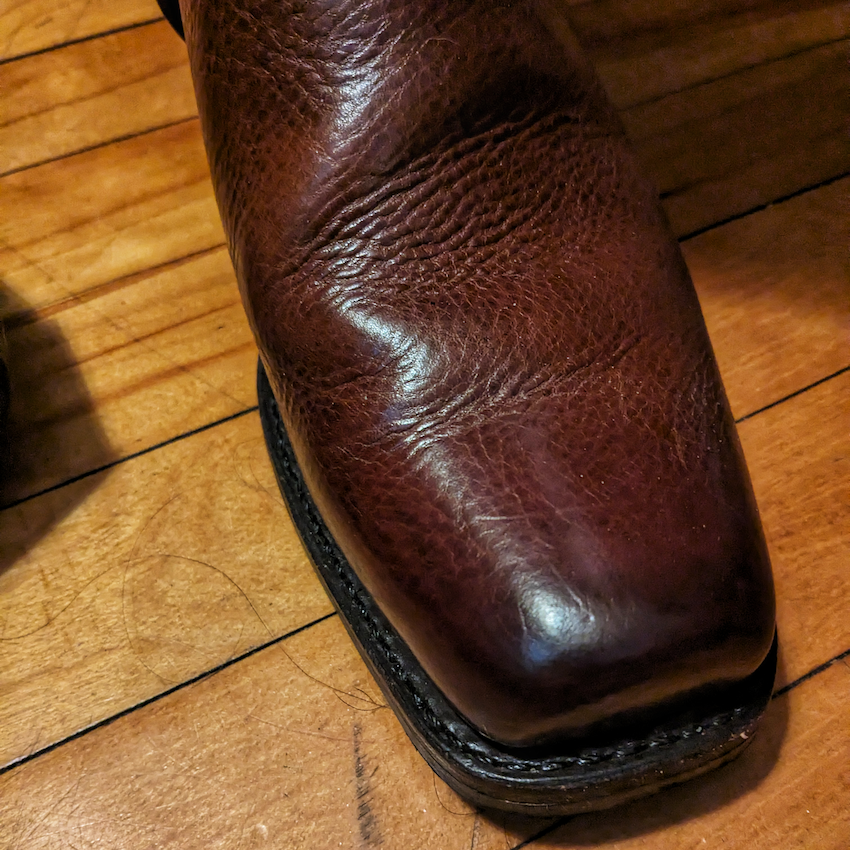
Toe box of Harness boots
(Image credit: sartorialsleaze)

Front and rear view of the Melissa otk boots
(Image credit: sartorialsleaze)
Melissa Over-The-Knee (OTK) -
As previously noted, this model was manufactured in Mexico, which a popular origin for many Heritage brands such as Bed Stu & Freebird Stores (formerly Freebird by Steve Madden), among others. As an equestrian-inspired model, it does a reasonable job of balancing comfort and style. These boots get worn a handful of times a year in the fall and winter and though the most inclement weather they have seen has been light snow and below-freezing temps they have generally held up well over the years.
Like the Harness boot, this model retailed for almost $500.
The Harlow - 2 variants featured -
I'll preface this section saying that I had high expectations for this style. In the early 2010's Frye began to design fashion-forward styles. Though I don't want to speak for a greater audience, I would theorize that the baseline assumption was that traditional heritage manufacturing would be blended with elements Frye hasn't really done before; higher and narrower heels, more aggressive platforms, unique ornamentations and the like. The Harlow was one of these examples, featuring a variety of shaft types, models of various ornamentation including lace-up styles, strappy belted styles, and a 'Campus' style that combined elements of the traditional Campus boot with an almond toe and a high, thick stiletto heel.
To say that this style was underwhelming is an understatement.
Of the Harlow variants I own, they were all manufactured in China. I particularly held excitement over the ankle boot as from it's design it had all the elements of cool and edgy...and with the Frye name there was a confidence that this was going to be a long lasting closet staple that would coordinate with almost anything...even with a $400 price tag. Was I ever duped.
The construction seems cemented, and not particularly well at that, and the tread wore down after maybe 6-7 wears. Using the images in this section as a reference the sole was a leather or leather board with a rubberized, treaded pad at the front.
Because of the nature of the style I picked up the taller shaft Harlow Moto boot, which featured an outside zipper and buckle detailing. They experienced the same tread peeling after a handful of wears as the ankle boots. Though at time of writing they're still functionally wearable, it was a huge disappointment when compared to the traditional Heritage styles.
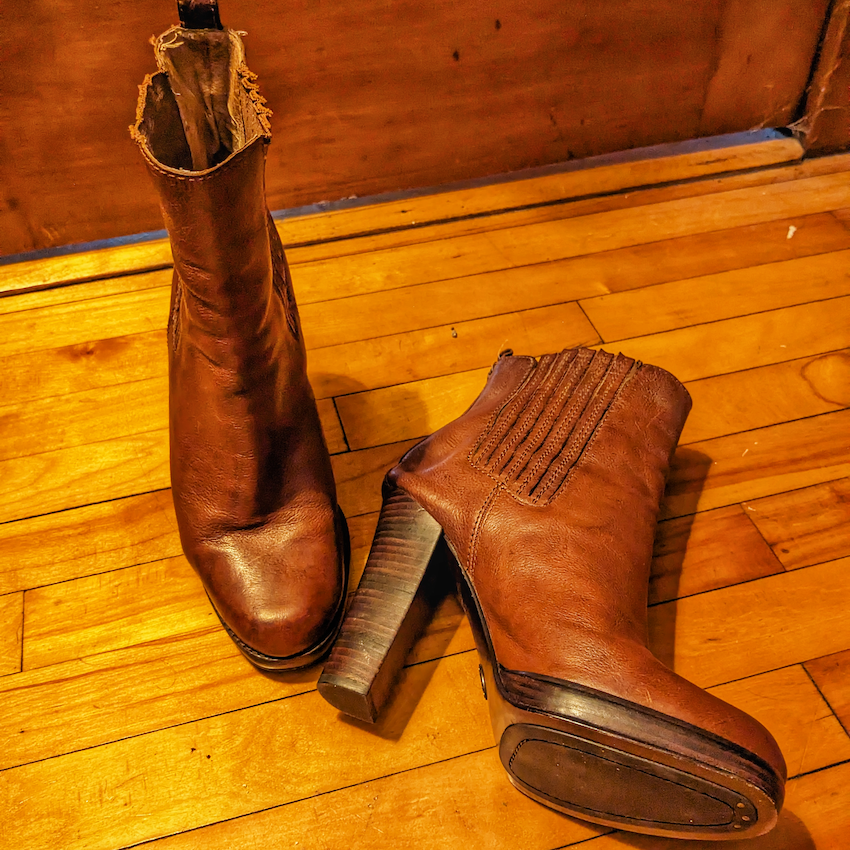
Frye Donna Chelsea ankle boot in cognac leather
(Image credit: sartorialsleaze)
Donna Chelsea -
If there's at least a consolation of the China-manufactured Fryes, it would probably be this boot. Though it seems to have a similar sole construction as the Harlow, the rubberized patch toward the toe box has the appearance of being sewed and tacked in. Featuring a slightly thicker heel and a more round toe than the Harlow, this model can be styled for fashion-forward casual looks, though it would be fine for a combination of looks. That said, they're not something to immediately reach for, they're just okay.
Retail price on initial release was in the low-mid $300 range
Summary/Closing Thoughts
With the examples above, there's a major variation of product quality, yet retail price points are nearly identical. In that thought it's at least worth asking, 'what determines value?' Is it disciplined, well-proven construction and manufacturing, is it unique products, though manufactured at mass? Perhaps it's simply a matter of individual perception and willingness to pay for something. However it plays out, I can only say the following with certainty:
- Value is not consistency in pricing with vast variation in product quality
- Value is not history and legacy in relation to a given product
- Value, often times, is not something that's trendy
As all of this relates to the Frye Company, it's a fair hypothesis to state that Frye's modern iteration is an exercise of a company that, for an extended period, rested on its laurels. Though many sing the praises of vintage Frye's and the value of craftsmanship, a lot of modern examples for this company are simply not comparable. Though Frye isn't the only example of quality perceived through legacy, it is a near tragedy given the interwoven history of this company with that of our nation as a whole.
Though I suppose there's a hope that Frye and other brands that have undergone major business transformation over the past 20-25 years find their balance between the things that gave them their identity and the ever-changing landscape of commerce and industry, it's a tough sell to acquire Frye's at retail price points as they're ridiculously overpriced.
Shoe Sanctimony Rating: 2.8 out of 5
(Editors Note: The review above is for 'Frye'. There is a subsidiary, 'Frye & Co.' in which the product line is focused more toward value-to-mid-range apparel.)
Citations & References:
1: “Frye’s Company Heritage.” The Frye Company, https://www.thefryecompany.com/pages/heritage, Retrieved 10-12-2023
“The Frye Company.” Wikipedia, Wikimedia Foundation, October 5 2023, https://en.wikipedia.org/wiki/The_Frye_Company, Retrieved 10-12-2023.
